UPDATED: Player Position to Start or Stop v3.0
For macOS 10.15 Catalina and later only. Sets the Start or Stop time of the currently paused or playing track to the time of the current player position.
Also seeCopy From Start to Stop and Reset Tracks Start-Stop.
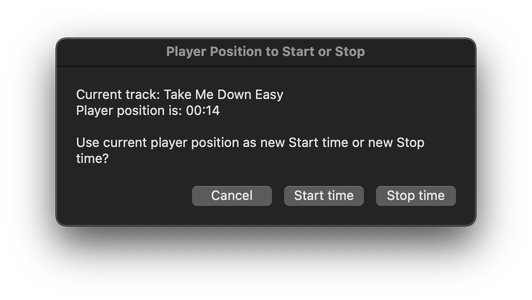
Latest version:
- Accommodations for macOS 10.15 Catalina
- Performance and security enhancements
More information for Player Position to Start or Stop v3.0 and download link is here.
UPDATED: Copy From Start to Stop v3.0
Makes a copy of the selected track using its Start and Stop times as the beginning and ending of the new file and adds to Library, with option to name new track/file. If using with file tracks, NOTE: you may experience some degradation of audio quality if you re-encode a file (one which has already been encoded), and thus the quality of your copy may be a matter of taste. Mileage will vary.
Also see Player Position to Start or Stop and Reset Tracks Start-Stop.
Latest version:
- Accommodations for macOS 10.15 Catalina
- Performance and security enhancements
More information for Copy From Start to Stop v3.0 and download link is here.
UPDATED: Remove From Other Playlists v2.0
This script will remove all replications of the selected tracks (or all the tracks in the selected playlist) from every other user-created playlist (ignoring Smart, Genius and Media Library playlists). The original tracks will not be removed from the selected playlist.
Also see Copy Tracks to Multiple Playlists.
More information for Remove From Other Playlists v 2.0 and download link is here.
UPDATED: Copy Tracks to Multiple Playlists v5.0
For macOS 10.15 Catalina and later only. This script will copy the selected tracks to one or more chosen playlists.
Also see Remove From Other Playlists.
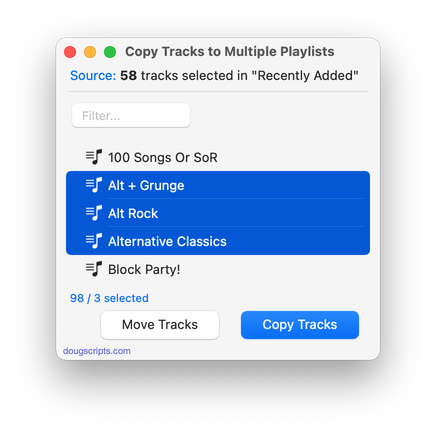
More information for Copy Tracks to Multiple Playlists v 5.0 and download link is here.
UPDATED: Comments Search v2.0
For macOS 10.15 Catalina and later only. This script will search the Comments tags of the Music library tracks for a user-entered text string and copy the track results to a discrete playlist.
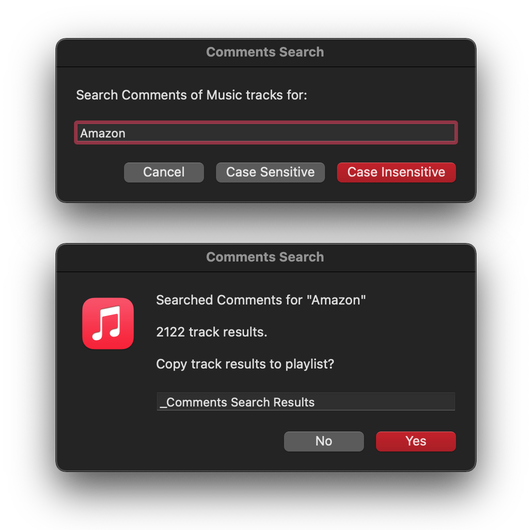
More information for Comments Search v 2.0 and download link is here.
UPDATED: This Tag That Tag v5.4
For macOS 10.15 Catalina and later only. This applet will assist with swapping, copying, and appending data between two user-chosen tags in selected tracks or tracks in the selected playlist:
Swap - swap data between tags, ex: ARTISTCOMPOSER
Copy - copy data from one to another tag, ex: ARTIST->COMPOSER ARTIST
Append - append data from one tag to the end of another, ex: ARTIST->COMPOSER - ARTIST
Prepend - append data from one tag to the beginning of another, ex: ARTIST->ARTIST - COMPOSER
The latter three actions also provide an option to delete the info from the first tag after the copy. Read Me explains all.
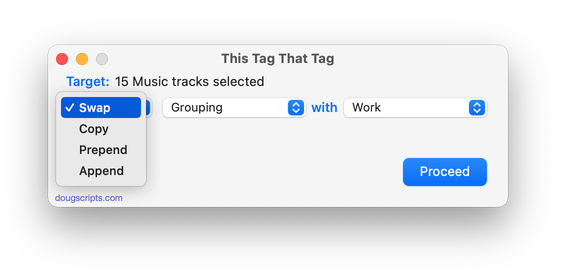
More information for This Tag That Tag v 5.4 and download link is here.
UPDATED: Re-Apply Downsized Artwork v4.0
For macOS 10.15 Catalina and later only. This applet will examine the artwork of each selected track (or tracks in the selected playlist) and if greater than a user-set resolution (n x n pixels) will downscale the image to that resolution. Artwork already at the set resolution or smaller will not be affected. Includes options to pad image to make square, preserve extant track artworks, adjust preview proportionally and export displayed artwork to disk.
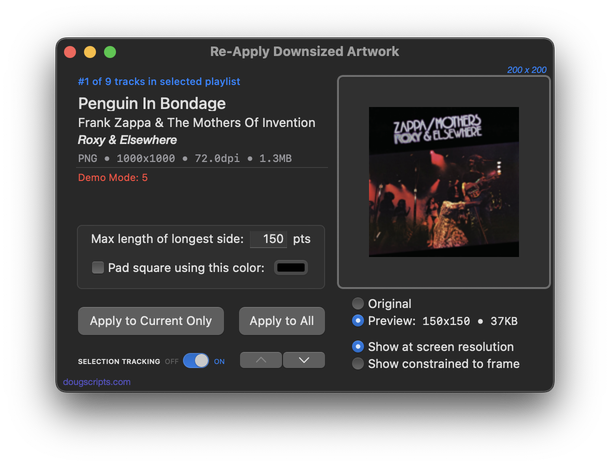
More information for Re-Apply Downsized Artwork v 4.0 and download link is here.
UPDATED: Rate Me! Rate Me! v6.0
For macOS 10.15 Catalina and later only. This stay-open applet watches your playing tracks and when one begins playing displays a notification-sized panel whereby a rating for the track can be entered. Features options to display only unrated playing tracks and timer preferences for how soon and how long the panel is displayed.
While you could easily rate the current track from the Music app's icon in the Dock, this script interrupts you and compels you to do so.
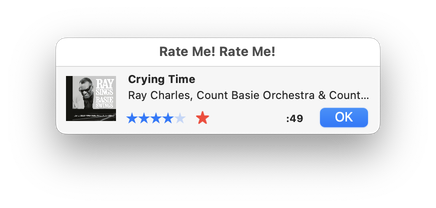
More information for Rate Me! Rate Me! v 6.0 and download link is here.
Accessing a Track's Multiple Artworks
In case you didn't know, a track entry in Music (and previously, in iTunes) can have more than one artwork image associated with it. In such cases, the first of its artworks is what I call the "display artwork" and the other artwork is what Apple calls...the "Other Artwork":
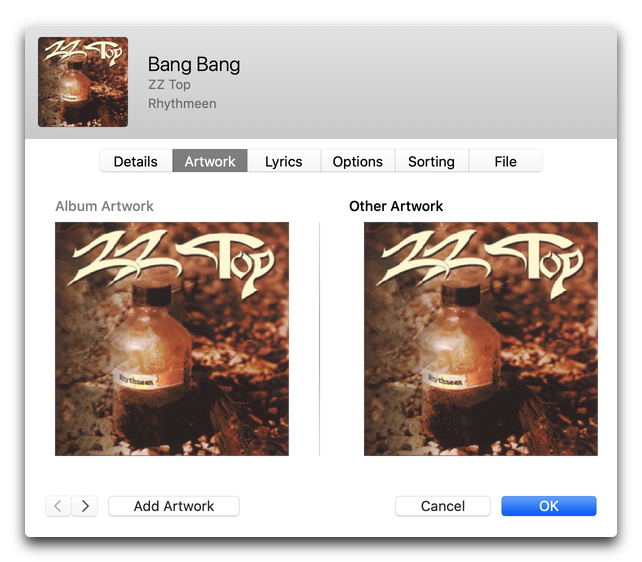
The "Album Artwork" image on the left is what is displayed throughout Music/iTunes as the artwork for the track. The "Other Artwork" doesn't get displayed anywhere except in the Artwork pane of the Info panel. And "Other Artwork" doesn't always mean other artwork singular; you can really go to town and add thousands if you want (probably; didn't try; crazy idea). Incidentally, I'm pretty sure only one image can be written a track's file metadata and that will be the "Album Artwork" image.
In AppleScript, a track contains artworks and each artwork is accessed by index: artwork 1, artwork 2...artwork 4732. The "display artwork" is always artwork 1.
I am currently preparing an update to the script Re-Apply Downsized Artwork, which, among other things, can insert a new down-scaled image as a track's artwork 1. If the track already has artworks, they are "pushed up" such that the current artwork 1 becomes artwork 2, the current artwork 2 becomes artwork 3, and so on, so that the new image can become the new artwork 1.
Here's the bug-or-feature part of the essay (mostly bug I'm thinking): When you ask for any other existing artwork greater than 1, Music gives up a parameter error. This makes it impossible for AppleScript to access any artwork data other than artwork 1.
I may release the update to Re-Apply Downsized Artwork that side-steps the "insert" feature, but I thought I'd explain why I haven't released it yet at all.
UPDATED: Coverscope v2.0
Coverscope is an applet that helps manage track and file artwork. It will display both the track entry artwork and the artwork metadata from the track's file:
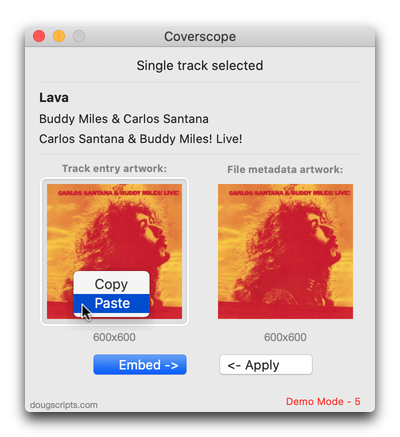
If one or the other is missing, the extant image data can be applied or embedded to the other. If both artworks are missing, an image from the clipboard can be pasted or an image file dragged to the Track entry artwork well to apply and embed it to the selected track.
Additionally, the Track entry artwork can be copied to the clipboard or exported as a file.
Coverscope is free to try in Demo Mode. In Demo Mode, any combination of features can be used up to five times per launch. A registration code to remove this restriction is US$2.99. More information and download is here.
And here's a cool trick I've been using Coverscope for:
(more…)
